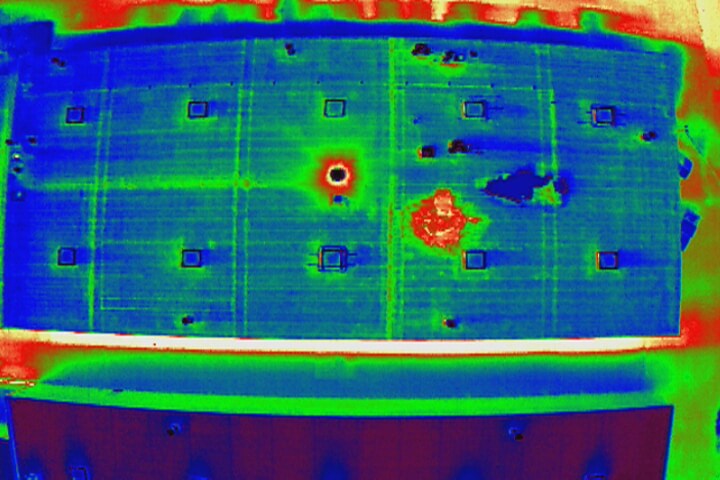Revolutionizing Commercial Roof Inspections

The Power of Infrared Drones
In the realm of commercial property management, few tasks are as vital as regular roof inspections. A well-maintained roof ensures the protection of assets and the safety of occupants. But what if there was a way to make these inspections not only more efficient but also more comprehensive? Enter the era of infrared drones for commercial roof inspections—a technological leap that’s transforming the way we assess roofing systems. In this blog, we’ll explore the world of infrared drones and delve into the benefits they bring to commercial roof inspections.
The Challenge of Roof Inspections
Commercial roofs endure a barrage of environmental elements, from harsh sunlight and rain to snow and wind. Over time, these elements can lead to wear and tear, causing leaks, structural issues, and energy inefficiencies. Regular inspections are essential to catch these problems early on and prevent costly repairs down the line.
Traditionally, roof inspections have involved manual labor, often requiring inspectors to climb onto the roof to assess its condition. Not only is this time-consuming and potentially dangerous, but it also doesn’t provide a complete picture of the roof’s health. This is where infrared drones step in to revolutionize the process.
Introducing Infrared Drone Roof Inspections
Infrared (IR) drones have brought a new level of sophistication to commercial roof inspections. Equipped with high-resolution cameras and thermal imaging technology, these drones can identify issues that are invisible to the naked eye. They capture both visual and thermal images of the roof, revealing temperature disparities that hint at underlying problems.
Thermal imaging is particularly valuable because it highlights temperature variations on the roof’s surface. Hotspots could indicate water damage, leaks, or insulation problems, while cold spots might suggest inadequate insulation or energy loss. By identifying these anomalies, infrared drones provide actionable insights that empower property managers and owners to address issues promptly.
The Benefits of Infrared Drone Inspections
Efficiency:
Infrared drone inspections are swift and efficient. Drones can cover large areas in a fraction of the time it would take a human inspector. This efficiency translates to cost savings and minimizes disruptions to daily operations.
Safety:
Climbing onto roofs can be hazardous for inspectors. Infrared drones eliminate the need for physical access to the roof, reducing the risk of accidents and injuries.
Accuracy:
The precision of thermal imaging allows drones to detect subtle temperature variations. This accuracy ensures that no issues go unnoticed, leading to more effective problem-solving.
Early Detection
Infrared drones can identify problems at an early stage, preventing minor issues from escalating into major repairs. This proactive approach extends the lifespan of the roof and saves on long-term maintenance costs.
Comprehensive Insights:
The combination of visual and thermal images provides a comprehensive view of the roof’s condition. This detailed data allows property managers to make informed decisions about repairs, replacements, and maintenance.
Energy Efficiency:
Infrared drones can identify areas of poor insulation or energy loss. Addressing these issues enhances the building’s energy efficiency, reducing utility costs and environmental impact.
How Infrared Drone Roof Inspections Work
Flight Planning:
A qualified operator plans the drone’s flight path, ensuring that
all areas of the roof are covered. The drone is equipped with an infrared camera and a visible light camera for visual images.
Data Collection:
As the drone flies over the roof, it captures both visual and thermal images. The thermal images display temperature variations, highlighting anomalies that could indicate underlying problems.
Image Analysis:
After the flight, the collected data is analyzed by professionals who are trained to interpret thermal images. Hotspots and cold spots are identified, and a comprehensive report is generated.
Reporting:
The final report includes visual and thermal images, highlighting areas of concern. This report serves as a valuable tool for property managers and owners to make informed decisions about maintenance and repairs.
The Future of Commercial Roof Inspections
As technology continues to evolve, the future of commercial roof inspections looks promising. Infrared drones are just the beginning, with advancements like machine learning and artificial intelligence potentially enhancing the capabilities of these inspections. Automated analysis algorithms could further streamline the process, making it even more efficient and accurate.
The adoption of infrared drone technology signals a shift towards a more proactive approach to property management. By identifying and addressing issues early on, property owners can extend the life of their roofs and ensure the long-term durability of their assets. Moreover, the energy-saving potential of these inspections aligns with sustainability goals, contributing to a greener future.
The integration of infrared drones into commercial roof inspections marks a significant leap forward in property management. These advanced tools combine efficiency, accuracy, and safety to provide comprehensive insights into the condition of commercial
roofs. From early issue detection to energy efficiency improvements, the benefits of infrared drone inspections are far-reaching and impactful. As technology continues to shape the landscape of property management, the era of infrared drones is undoubtedly transforming how we care for our commercial structures, one roof at a time.

